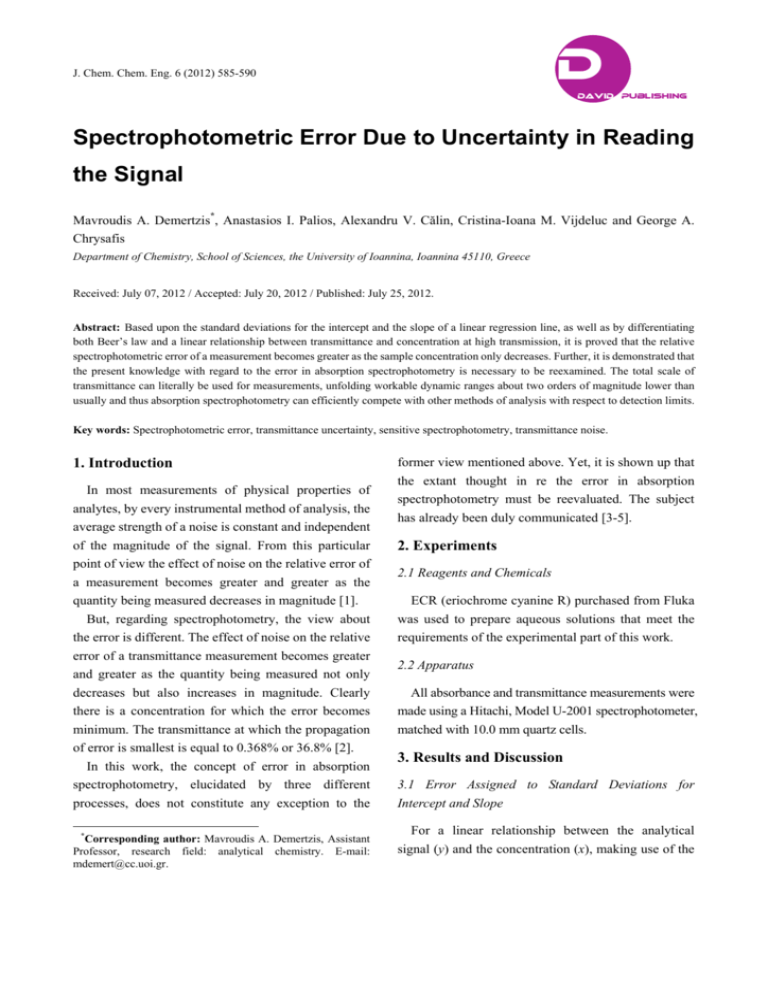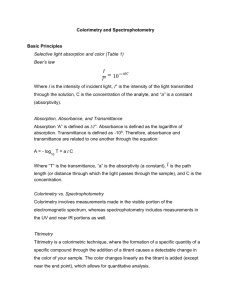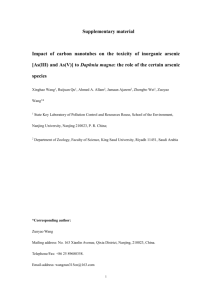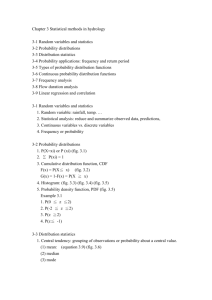Spectrophotometric Error: Uncertainty in Signal Reading
advertisement

D J. Chem. Chem. Eng. 6 (2012) 585-590 DAVID PUBLISHING Spectrophotometric Error Due to Uncertainty in Reading the Signal Mavroudis A. Demertzis*, Anastasios I. Palios, Alexandru V. Călin, Cristina-Ioana M. Vijdeluc and George A. Chrysafis Department of Chemistry, School of Sciences, the University of Ioannina, Ioannina 45110, Greece Received: July 07, 2012 / Accepted: July 20, 2012 / Published: July 25, 2012. Abstract: Based upon the standard deviations for the intercept and the slope of a linear regression line, as well as by differentiating both Beer’s law and a linear relationship between transmittance and concentration at high transmission, it is proved that the relative spectrophotometric error of a measurement becomes greater as the sample concentration only decreases. Further, it is demonstrated that the present knowledge with regard to the error in absorption spectrophotometry is necessary to be reexamined. The total scale of transmittance can literally be used for measurements, unfolding workable dynamic ranges about two orders of magnitude lower than usually and thus absorption spectrophotometry can efficiently compete with other methods of analysis with respect to detection limits. Key words: Spectrophotometric error, transmittance uncertainty, sensitive spectrophotometry, transmittance noise. 1. Introduction In most measurements of physical properties of analytes, by every instrumental method of analysis, the average strength of a noise is constant and independent of the magnitude of the signal. From this particular point of view the effect of noise on the relative error of a measurement becomes greater and greater as the quantity being measured decreases in magnitude [1]. But, regarding spectrophotometry, the view about the error is different. The effect of noise on the relative error of a transmittance measurement becomes greater and greater as the quantity being measured not only decreases but also increases in magnitude. Clearly there is a concentration for which the error becomes minimum. The transmittance at which the propagation of error is smallest is equal to 0.368% or 36.8% [2]. In this work, the concept of error in absorption spectrophotometry, elucidated by three different processes, does not constitute any exception to the * Corresponding author: Mavroudis A. Demertzis, Assistant Professor, research field: analytical chemistry. E-mail: mdemert@cc.uoi.gr. former view mentioned above. Yet, it is shown up that the extant thought in re the error in absorption spectrophotometry must be reevaluated. The subject has already been duly communicated [3-5]. 2. Experiments 2.1 Reagents and Chemicals ECR (eriochrome cyanine R) purchased from Fluka was used to prepare aqueous solutions that meet the requirements of the experimental part of this work. 2.2 Apparatus All absorbance and transmittance measurements were made using a Hitachi, Model U-2001 spectrophotometer, matched with 10.0 mm quartz cells. 3. Results and Discussion 3.1 Error Assigned to Standard Deviations for Intercept and Slope For a linear relationship between the analytical signal (y) and the concentration (x), making use of the 586 Spectrophotometric Error Due to Uncertainty in Reading the Signal method of least squares, the best-fitted straight line through the calibration graph points is calculated. This line, known as the line of regression of y on x, is used to estimate the concentrations of the test samples [6]. A linear regression line is represented by the first-order equation: y = a + bx (1) In the case of Beer’s law y = A, x = C and a = 0. By including the standard deviation of the intercept, sa, which is proportional to the instrumental noise or the uncertainty in reading the signal [6], Eq. (1) becomes y = (a ± sa ) + bxs (2) Where, xs is related to the individual x-value and depends upon sa. By combining Eqs. (1) and (2), it is taken xs − x = ± sa b (3a) The difference xs-x obviously represents the absolute error in x, which is constant for individual x-values. Therefore, the standard deviation of the intercept involves a parallel displacement on both sides of the regression line, as shown in Fig. 1a for a negative value of sa. Moreover, the absolute error in x, relating to the standard deviation of the intercept can also be unmistakably found from Fig. 1a geometrically. Since the standard deviation of the intercept for a linear regression line involves an identical absolute error in Fig. 1a concentration for any solution, the relative error of a measurement, Eq. (3b), clearly becomes greater as the concentration of a standard or a sample solution decreases. xs − x s =± a x bx (3b) On the other hand, by including the standard deviation of the slope, sb, which also is proportional to the uncertainty in reading the signal, Eq. (1) becomes y = a + (b ± sb ) xs (4) y = a + bxs ± sb xs (5) or Eqs. (1) and (4) given xs = ± bx b ± sb (6) while Eqs. (1) and (5) given xs − x = ± sbx s b (7) sbx b ± sb (8) Finally, Eqs. (6) and (7) given xs − x = ± Here the absolute error in x, xs-x, is directly proportional to the individual x-values, while the relative error, Eq. (9), is constant for any solution. It is evident that the standard deviation of the slope brings along an angular displacement on both sides of the regression line, as shown in Fig. 1b for a positive change of sb. Effect of a negative standard deviation of intercept on a linear regression line of analytical signal vs. concentration. Spectrophotometric Error Due to Uncertainty in Reading the Signal Fig. 1b 587 Effect of a positive standard deviation of slope on a linear regression line of analytical signal vs. concentration. The absolute error in x can also be geometrically found from Fig. 1b. xs − x sbx s =± =± b x (b ± s b ) x b ± sb (9) ΔA ΔC = A C (12) Based upon the data of Fig. 2a and using Eq. (12), a plot of ΔC/C vs. C is shown in Fig. 2b. Thus, the final effect is that the relative error increases as the measured x-value decreases in magnitude. This state is inviolable for every straight regression line, independently of the technique used to take experimental data. 3.2 Error Inherent to Absorbance Measurement A host of measurements performed in our laboratory for several absorbing species and covering the total scale of reading, furnished working graphs of very good linearity between absorbance and concentration, as shown in Fig. 2a. As already mentioned, a linear relationship between absorbance and concentration indicates that the relative error must be greater for smaller concentrations. This conclusion is confirmed by a direct differentiation of Beer’s law, (10) A = εbC that gives (11) dA = εbdC By substituting A/C for εb and using finite values instead of infinitesimals, Eq. (11) becomes Fig. 2a Absorbance of ECR solutions for concentrations 0.001 to 1 mM at 377 nm. Fig. 2b Relative error of ECR solutions for concentrations 0.001 to 1mM at 377 nm; ΔΑ = 0.0002. 588 Spectrophotometric Error Due to Uncertainty in Reading the Signal Clearly, the relative error in concentration is inversely proportional to the absorbance, viz. greater only for smaller concentrations. 3.3 Error Inherent to Transmittance Measurement Corresponding to the data of Fig. 2a, a plot of transmittance vs. concentration is shown in Fig. 3a. For about T > 0.8 a linear relationship between the variables is apparent, representing an equation of the first degree as follows: (13) T = a - kC For C = 0, T = a. Because incident beam, Po, is equal to emergent beam, P, T = P/Po = 1. Thus, a = 1 and Eq. (13) is definitely written as (14) T = 1 - kC By differentiating Eq. (14) and proper substituting for k, dT and dC it is finally taken: ΔΤ ΔC − = (15) 1− Τ C From a plot of ΔC/C vs. C, shown in Fig. 3b, it is evident that the error anew is greater only for smaller concentrations. Further, substituting P/Po for T and readjusting, Eq. (14) can be changed into the following forms: (16) P = Po - kPo C Po - P = kC (17) Po and Po - P = kPo C (18) Here, it is noticed that Eq. (18) is analogous to the next one, Po - P = 2.303εbCPo (19) which is a result of Beer’s law in the form shown in Eq. (20), provided the fraction of the absorbed light, (Po - P)/Po , is ≤ 0.05; namely Eq. (19) is applicable at high transmission for T ≥ 95%. P = e -2.303εbC Po (20) An efficient, well accurate and precise spectrophotometric procedure, based on Eq. (19) and providing remarkably law detection limit has been Fig. 3a Transmittance of ECR solutions for concentrations 0.001 to 1 mM at 377nm. Fig. 3b Relative error of ECR solutions for concentrations 0.001 to 0.006 mM at 377 nm; ΔΤ = 0.0004. proposed; in this case transmission measurements were performed using a fluorescence spectrometer not a spectrophotometer [7]. 3.4 Current Thought about the Error Absorption spectrophotometry is one of the most useful and widely used techniques available to the chemists for quantitative analysis, numbering numerous applications that touch upon every field in which quantitative chemical information is required [1]. In spite of that, highly sensitive spectrophotometric methods have not been developed as a result of large error in concentration, that was thought to be cohered with readings not only more than 80% T but also less Spectrophotometric Error Due to Uncertainty in Reading the Signal than 10% T [2], according to the coming equation dC 0.4343 dT = TlogT C (21) A plot of Eq. (21), using the data of Fig. 2a, is shown in Fig. 4. However, Eq. (21) is a product of wrong differentiation calculus. Beer’s law was faulty transposed to the form 0.4343 lnT C= − (22) εb which then was differentiated to provide Eq. (21). In mathematical language, when y is a function of x, then this relation is expressed by the equation: y = f(x) (23) It may be said that the dependent variable, y, changes, when the independent variable, x, changes [8]. But C in Eq. (22) as a dependent variable does not change, when the independent variable, T, changes. Thus, from a physical point of view differentiation of Eq. (22), as well as Eq. (21), are both without any sense. Conversely, differentiation of Beer’s law, shown in Eq. (24), finally provides Eq. (25), (24) - 0.4343lnT = -logT = εbC d(-logT) dC = (25) C - logT which is correct and equivalent to Eq. (12). In addition, d(-logT) is just a differential, while the derivative of -logT with respect to C, Eq. (26), is equal to the slope, that is right for a linear relationship [8], such as Beer’s 589 law. Oppositely, the derivative of C with respect to T is not equal to the slope in the case of Eq. (22), referring to a non-linear relationship between the variables. d(-logT) - logT = = εb dC C (26) Eq. (21), published some decades ago, was adopted and well established from the total of the educational manuals, viewing instrumental chemical analysis. In this way, Eq. (21) constituted the touchstone for the level of growth of the absorption spectrophotometry with respect to impossibility of attainment lower detection limits. A misconception for concentration error has prevented the technique’s promotion long ago. 4. Conclusions The present-day perception regarding the error in absorption spectrophotometry must be reviewed. Accurate and sensitive spectrophotometric methods can be acquired by going to the edge of the transmittance scale, for instance, the relative error in concentration for a transmittance value equal to 95% is hardly less than 1%, while for T% = 99 the relative error is about 4%. Absorption spectrophotometry is an authentic, opportune and valuable technique for trace analysis and can efficiently compete with contemporary methods with respect to detection limits. Finally, the linear relationship of transmittance or its secondary dependent variables vs. concentration is particularly practical for quantitative analysis at high transmission. References [1] [2] [3] Fig. 4 Relative error of ECR solutions for concentrations 0.001 to 1 mM at 377 nm; ΔΤ = 0.0004. Skoog, A. D.; Holler, F. J.; Nieman, T. A. Principles of Instrumental Analysis; 5th Ed., Thomson Learning Academic Resource Center, United States, 1998; pp 99-342. Hiskey, C. F. Principles of Precision Colorimetry. Anal. Chem. 1949, 21, 1440-1446. Călin, A. V.; Vijdeluc, C. I.; Fiamegos, Y. C.; Stalikas, C. D.; Kovala-Demertzi, D.; Demertzis, M. A. In Sensitive Spectrophotometric Determination of Copper with di-2-pyridyl Ketone, Proceedings of the 9th Eurasia Conference on Chemical Sciences (EuAs C2S-9), Antalya, Turkey, 2006, Ohtaki, H.; Şener, B. Eds.; 2006, 590 [4] [5] Spectrophotometric Error Due to Uncertainty in Reading the Signal B-OP-4, p 26. Demertzis, M. A.; Călin, A. V.; Vijdeluc, C. I.; Fiamegos, Y. C.; Stalikas, C. D.; Kovala-Demertzi, D. In Errors in Spectrophotometry, Proceedings of the 5th International Conference on Instrumental Methods of Analysis-Modern Trends and Applications, Rio-Patras, Greece, Christopoulos T. K., Ioannou, P.C. Eds., 2007, OR 274. Demertzis, M. A.; Palios, A. I.; Călin, A. V.; Vijdeluc, C. I.; Chrysafis, G. A. In Spectrophotometric Error Due to Uncertainty in Reading the Signal, Proccedings of the [6] [7] [8] 12th Eurasia Conference on Chemical Sciences (EuAs C2S-12), Corfu, Greece, Kitagawa, S., Hadjiliadis, N., Eds., 2012, S10-OP9. Miller, J. C.; Miller, J. N. Statistics for Analytical Chemistry; John Wiley and Sons, New York, 1988; pp 109-112. Demertzis, M. A. Low Detection Limit Spectrophotometry. Anal. Chim. Acta 2004, 505, 73-76. Farrington, D. Mathematical Preparation for Physical Chemistry; McGraw-Hill Book Company, Inc., New York, 1956; pp 70-91.







